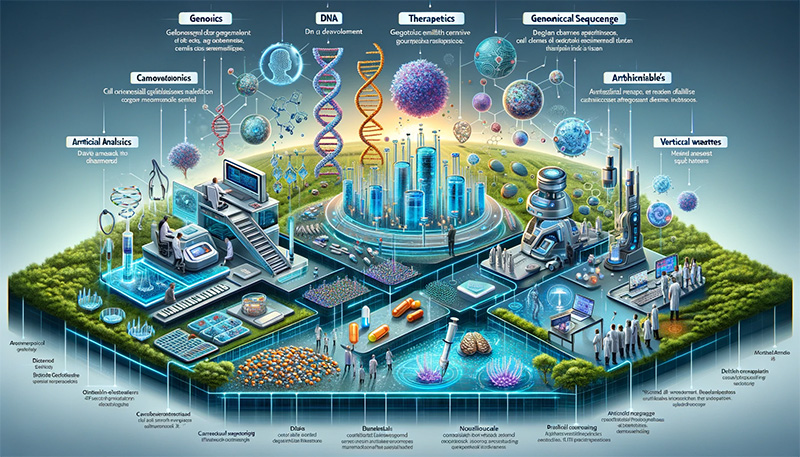
As we leap into 2024, the healthcare system stands poised for disruption. Rising costs, inequities, and quality concerns may loom large, but a surge of innovation fuelled by genomics, therapeutics, and AI beckons. This convergence holds immense potential to unlock a new era of personalized medicine, optimize patient interactions, and streamline care delivery, fundamentally reshaping how we tackle medical challenges.
Unleashing the Power of Data: Healthcare Analytics and AI
Healthcare is the world’s data behemoth, generating astronomical amounts of information through digital monitoring, treatment options, and research. Artificial intelligence and machine learning are now poised to unlock the vast potential within this data, transforming it into actionable insights. This transformation will empower a multitude of advancements, including:
- Drug discovery: AI can analyze vast datasets of genomic and clinical data to identify promising drug targets, significantly accelerating the development of new therapeutics.
- Patient interactions: AI-powered chatbots and virtual assistants can provide personalized support, answer patient questions, and offer guidance on medication adherence and lifestyle modifications.
- Care delivery: AI algorithms can assist with scheduling appointments, optimizing patient flow, and predicting potential complications, leading to smoother and more efficient healthcare delivery.
The healthcare analytics segment is projected to be a key driver, propelling the digital health market toward a colossal $400 billion opportunity by 2030.
Democratizing Healthcare: Genomic Sequencing and Personalized Medicine
Genomic sequencing has undergone a radical transformation. Technological advancements and research breakthroughs have significantly reduced costs, expanding access to this once-prohibitively expensive technology. Today, sequencing an individual’s genome costs roughly $600, a dramatic departure from the tens of millions it cost in the 1990s. Predictions suggest that a $100 price point could be the tipping point for widespread adoption, making it widely accessible to individual consumers.
This affordability unlocks the immense potential of personalized medicine, where treatments are tailored to each individual’s unique genetic makeup. Genomic technologies are already impacting clinical practice in areas like early cancer diagnosis, neurological disorders, disease testing, and reproductive health. The market for these technologies is anticipated to double by 2027, reaching a staggering $8.4 billion.
Furthermore, genomics is fuelling the pharmaceutical industry. Drug development is accelerating as targeted therapies emerge, enabling pharmaceutical companies to focus their efforts on areas with the highest success potential and greatest patient impact. For instance, new weight-loss treatments are a testament to this targeted approach.
The healthcare industry is also exploring genomic technologies for directly or indirectly modifying a patient’s DNA to address common diseases. These “genomic medicines” are projected to be the fastest-growing pharma segment, with a compound annual growth rate of 47% through 2028. Gene therapies alone are expected to constitute a nearly $50 billion market by 2028.

Reimagining Treatment: Digital Medicine and the Future of Care
The future of digital medicine goes beyond the healthcare apps we know today. Inefficiencies in patient care are paving the way for innovative digital health tools that streamline and automate medical processes. AI is at the forefront of these advancements, promising to improve treatment outcomes and deliver cost savings of up to $360 billion annually to the U.S. healthcare system alone.
For instance, AI-powered surgical robots are shortening hospital stays and facilitating faster, less painful recoveries. Their affordability and acceptance are steadily increasing, with only 5% of surgeries utilizing them today, but an estimated 78% of U.S. surgeons expressing interest in adopting them.
With wider access to affordable, readily usable medical data, the benefits for pharmaceutical developers, physicians, and patients will expand rapidly. This expansion, coupled with AI’s growing ability to identify key markers in increasingly affordable genomic data, positions us on the cusp of groundbreaking advancements in patient care and disease treatment.
A Landscape of Innovation
Various innovative technologies can be categorized into different stages of adoption based on how readily people embrace them. Here’s a glimpse into each theme’s trajectory:
Pioneers:
- Cardiovascular Wearables: Attracting interest from innovative companies and researchers, these wearables are paving the way for personalized heart health monitoring.
- Neurological Wearables: This early-stage theme carries enormous promise for revolutionizing the diagnosis and management of neurological conditions like Parkinson’s and Alzheimer’s disease. Advancements in brain-computer interfaces and wearable EEG devices are paving the way for personalized neuro-monitoring and treatment options.
- Cell & Gene Therapies: Showing promise in clinical trials, these transformative therapies are gaining traction among early adopters in the medical community.
Trendsetters:
- Diabetes Wearables: Similar to cardiovascular wearables, these wearables are gaining traction among early adopters but have not yet reached mainstream use. They hold immense potential for real-time glucose monitoring and personalized diabetes management.
- Blood-Based Alzheimer’s Tests: This rapidly evolving theme is attracting significant interest from the medical community, as it offers the potential for non-invasive Alzheimer’s detection through simple blood tests. While still in the early stages of development and clinical testing, it holds immense promise for early diagnosis and improved patient outcomes.
Pragmatists
- Genomic Sequencing: Becoming increasingly affordable and accessible, genomic sequencing is on the cusp of wider adoption by healthcare providers.
Convergence and Collaboration: Paving the Way for a Brighter Future
The convergence of genomics, therapeutics, and AI signifies a transformative force in healthcare. This confluence of innovation holds immense potential to:
- Prevent and diagnose diseases earlier and more accurately. For example, genomic sequencing can identify individuals at risk for specific diseases, allowing for proactive preventive measures.
- Develop personalized treatment plans with increased efficacy and reduced side effects. By factoring in individual genetic variations, tailored therapies can be implemented, leading to more effective and targeted treatment regimens.
- Optimize healthcare delivery, making it more efficient and accessible. AI-powered tools can streamline administrative tasks, automate medical processes, and improve patient flow, leading to a more efficient and accessible healthcare system.
- Empower patients with greater control over their health and well-being. Wearables and digital health platforms can provide patients with real-time health data and insights, enabling them to actively participate in their own healthcare decisions.
However, realizing this potential requires collaboration. Open access to data, fostering partnerships between technology developers and healthcare providers, and prioritizing ethical considerations are crucial elements to ensure equitable access and responsible implementation of these powerful technologies. By fostering a collaborative environment and addressing ethical concerns, we can ensure that this technological revolution translates into a brighter future for healthcare, where personalized medicine, efficient care delivery, and patient empowerment become the norm.
Prof. Dr. Prahlada N. B
22 December 2023
Chitradurga.
References:
- Porter, M.E., & Lee, T.H. (2013). The Strategy That Will Fix Health Care. Harvard Business Review.
- Topol, E. (2019). Deep Medicine: How Artificial Intelligence Can Make Healthcare Human Again.
- Davenport, T.H., & Kalakota, R. (2019). The Potential for Artificial Intelligence in Healthcare. Future Healthcare Journal, 6(2), 94–98.
- Obermeyer, Z., & Emanuel, E.J. (2016). Predicting the Future — Big Data, Machine Learning, and Clinical Medicine. New England Journal of Medicine, 375(13), 1216-1219.
- Collins, F.S., & Varmus, H. (2015). A New Initiative on Precision Medicine. New England Journal of Medicine, 372(9), 793-795.
- National Human Genome Research Institute. (2020). The Cost of Sequencing a Human Genome.
- Meskó, B., Drobni, Z., Bényei, É., Gergely, B., & Győrffy, Z. (2017). Digital Health is a Cultural Transformation of Traditional Healthcare. mHealth, 3, 38.
- Jha, A.K., Topol, E.J. (2016). Adapting to Artificial Intelligence: Radiologists and Pathologists as Information Specialists. JAMA, 316(22), 2353-2354.
- Khanna, S., & Sambandam, S.N. (2014). Digital Health: A Path to Validation. NPJ Digital Medicine, 2, 38.
- MobiHealthNews. (2023). Trends in Digital Health.
- Christensen, C.M., Grossman, J.H., & Hwang, J. (2009). The Innovator’s Prescription: A Disruptive Solution for Health Care. McGraw-Hill.
- Frenk, J., & Moon, S. (2013). Governance Challenges in Global Health. New England Journal of Medicine, 368(10), 936-942.

















True Prahlada Sir,
The convergence of genomics, therapeutics & Al , enables us to have :
* personalised medicine
* improved treatment outcomes &
* newer effective therapies
This convergence of 3, though holds immense promise, there are challenges like privacy concerns surrounding the genomic data. If these ethical concerns are effectively addressed, then this convergence of , & collaboration between the '3' , offers the opportunity to shift from a reactive model of healthcare to a precise, proactive & individualised approach…..ultimately leading to better health outcomes.
Reply